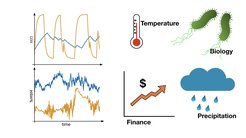New random walk model elucidates hidden spatio-temporal patterns governing evolution of complex systems

Random walk models and stochastic processes have long been the pillars to elucidate the space-time evolution of complex systems in diverse fields, such as biology, finance, climate and neuromorphic computing, to name a few. Recent experiments tracking organelles in biological cells or financial market data report clear variations in their spatio-temporal scaling properties. The international team of scientists from Indian Institute of Technology Guwahati, Kharkiv Institute of Physics and Technology, Wroclaw University of Science and Technology, University of Potsdam, MPI for the Physics of Complex Systems, and MPI of Microstructure Physics present a new random walk model, Telegraphic Multifractional Brownian Motion (TeMBM) to unravel the physical mechanisms underlying the scaling properties in such systems. The researchers provide a method to identify TeMBM in experimental data, as demonstrated for time series from climate, biology, and finance. TeMBM builds on long-range-correlated stochastic models originally developed by Kolmogorov, Mandelbrot, and van Ness, so-called fractional Brownian motion (FBM). FBM exhibits statistically similar patterns at all time scales and is characterized by the constant Hurst exponent. FBM finds applications in solid state physics, biology and finance due to their distinct correlations.
However, FBM cannot explain the highly complicated scaling phenomena observed in many complex systems where the estimated values of the Hurst exponent are seen to vary over time. The TeMBM model is a generalization of FBM designed to incorporate this property, and can mimic properties such as the probability distribution of the Hurst exponents reported in single particle tracking experiments. The authors also provide a simple yet efficient method to distinguish between TeMBM and conventional FBM in experimental data. TeMBM and the results presented in this paper promise the detection and description of unexpected commonalities in various, at first glance, unrelated areas.
The paper entitled "Multifractional Brownian Motion with Telegraphic, Stochastically Varying Exponent" can be found at
https://doi.org/10.1103/PhysRevLett.134.197101










